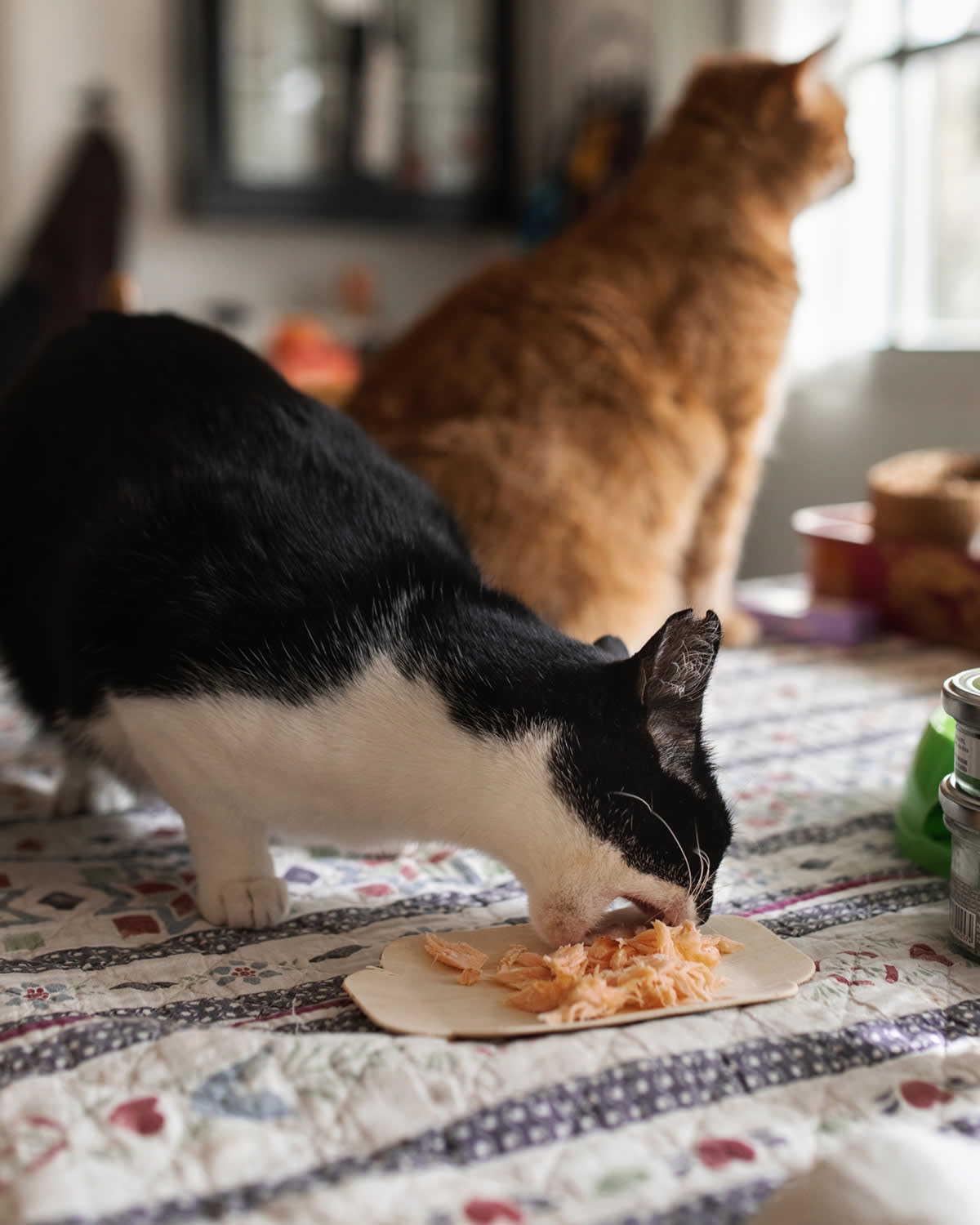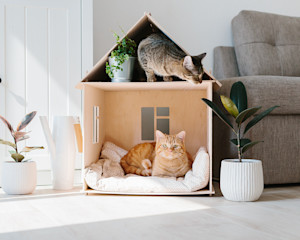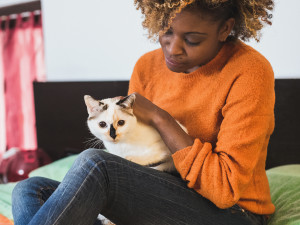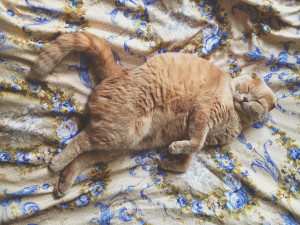The Multi-Cat Food Drama No One Warns You About
One chonky cat, three hungry housemates – here’s how to fix it

Share Article
Picture this: you’re watching your cats at dinner time, and while one delicately nibbles their kibble, the other is practically inhaling everything in sight – including their sibling’s leftovers. Sound familiar? If you’re nodding along, you’re not alone in this multi-cat household struggle.
Whether you’ve adopted a new cat who’s carrying some extra weight or you’ve got a greedy kitty who likes to take an extra share of treats, you might be considering putting your cat on a diet. And here’s the thing – when there’s just one cat at home, it’s simple enough. You can carefully monitor how much food they’re getting. But when you have two or more cats, and only one needs to go on a diet, how can you ensure they’re not eating more than they need while making sure the others get enough food at the same time?
The good news? This is totally fixable. We’ve spoken to some experts to find out how to make things easier. From knowing when it’s time to go on a diet in the first place to the different ways to feed an overweight cat separately, it’s all in here.
How to I know if my cat needs to go on a diet?
First things first, how do we know it’s time for a diet? The ideal weight for your cat will vary based on factors like their age, breed and gender, so your vet can help you find out if you’re unsure. However, simply looking at your cat will give you an indication.
“Ideally, cats should have a waistline or ‘hourglass’ figure where their waist goes in slightly just past their ribs when viewed from above,” explains Dr Angela Rollinsopens in new tab, clinical professor of small animal nutrition at the University of Tennessee College of Veterinary Medicine. “Once they start to look like a straight tube or have their belly’s pouch out, they are overweight.”
Meanwhile, if your cat weighs more than 10 percent over their ideal body weight, they’re likely to be considered overweight. If they weigh more than 20 percent, they may be classed as obese.
Why is maintaining a healthy weight important?
Just like for humans, being a healthy weight reduces the risk of developing certain health conditions in cats. Urinary conditions, diabetes and arthritis are all a higher risk for overweight and obese cats. “Obese cats have an overall poorer quality of life and, based on data in dogs and rodents, will likely have a shorter lifespan as well,” adds Dr Rollins.
It’s not just about health conditions, though. Being overweight can affect your cat’s ability to groom themselves and move around as cats naturally do – and we all want our feline friends living their best lives.
How to feed an overweight cat separately
Now, let’s talk about the real challenge. Even if two or more cats are fed at the same time with the same access to food, it’s possible that just one might become overweight. It could be because one is less active, because they’re more confident in helping themselves when sharing food, or because you’re free feeding your cats and they’re more inclined to keep coming back.
Georgia Woods-Leeopens in new tab, clinical lead for the Weight Management Clinic at the University of Liverpool and a British Small Animal Veterinary Association (BSAVA) volunteer, has a solution: she advises meal feeding instead to better monitor your overweight cat’s food intake.
“Giving 30 minutes of supervised access to food 2–3 times a day will mean no food stealing can occur,” she advises. “The cat on a diet may be best fed in a separate room during meals, particularly if they are very keen to swap bowls.”
Because cats are crepuscular – most active at dawn and dusk – try to feed them at these times to mimic their natural hunting behaviours.
Here’s where technology can be your best friend: particularly if your other cats are used to free feeding and you don’t think they’d adapt well to set mealtimes, microchip-activated food bowls such as the SureFeed Microchip Pet Feederopens in new tab or the Closer Pets MiBowl Automatic Selective Microchip Pet Feederopens in new tab could work for your household.
“The cats who are not on the diet are given access to the microchip bowls, allowing them to graze throughout the day,” Woods-Lee explains. “This also means the cat on the diet can only access their own food and won’t be able to sneak any extras.”
Other similar feeders use radio-frequency identification (RFID) to make sure the right cat has access – the cat you want accessing the feeder would wear a tag on their collar. Dr Rollins highlights the PortionProRx Automatic Pet Feederopens in new tab and PetLibro One RFID Pet Feederopens in new tab as two examples.
The best part? This ensures that your other cats are getting enough food themselves – they aren’t missing out while you’re helping their housemate get healthier.
How do I know how much food to give my cat?
“Feeding guidelines on bags of food may be higher than a typical housecat needs,” explains Dr Rollins. “We should always provide the amount of food needed by the cat at their ideal weight, not necessarily their current weight if they are too heavy.”
Start by feeding your cat an amount based on their target weight, but if they’re still weighing too much after a few weeks, reduce gradually by about 10 percent until they begin slowly and steadily losing weight. Make sure to speak to your vet if you need any advice or are unsure – they’re there to help you succeed.
What about treats?
Let’s be honest – it’s easy to lose track of how many treats you give your cats, particularly if there’s more than one human in the house to deal them out. The solution? Carefully plan out your treats, and ensure everyone is on the same page. You don’t have to give your cats treats every day, and when you do, low-calorie ones might be better. Treats should make up 10 percent of your cat’s daily calories.
“Another good option, which is well accepted by some cats, is cooked courgette,” adds Woods-Lee. “As weird as it sounds, peeled and cooked courgette can be a nice, very low-calorie, high-water treat for any of the cats in a household.”
What else can I do to help my cat?
While a healthy diet and sensible portions are very important, exercise is a factor too. Even indoor cats can get plenty of exercise – why not put their food in a feeding toy or scatter it around to help them engage in their natural behaviours?
Make sure you set aside some time each day to play with toys, too. Wands, springs and balls can all help them move around and keep active.
The bottom line: how to put one cat on a diet in a multi-cat household
Remember, if you’re in doubt, it’s always best to speak to your vet. They will be able to offer advice, help you formulate meal plans, and potentially advise you on the best products, such as microchip-activated bowls or low-calorie treats.
Make sure you come to an agreement with your partner or flatmates, too. That way, you can work together, and your cat won’t be getting fed more often than they should be or getting extra treats.
After all, you, your vet, and the other people in your household are all on the same team. You all want a cat who’s going to be healthy and happy for as long as possible.

Adam England
Adam England is a lifestyle and culture journalist who has written for publications including PetsRadar, Verywell Mind, People and Healthline. He shares two rescue cats, Bunny and Dougie, with his girlfriend and when he’s not working, he’s visiting his parents’ Golden Retriever, or getting into arguments over music.
Related articles
![]()
7 Ways to Manage a Multi-Cat Household
The dream is not without it’s challenges
![Woman feeds gray cat dry food.]()
Does Your Cat Need a High-Protein Diet Like the Lads At the Gym?
While they might not be working on their ‘gains’, there are other reasons this diet could be a good fit
Is a Plant-Based Diet Safe for Your Cat or Dog? Experts Weigh In
Curious about a plant-based diet for your pet? Discover what science has to say about it
![A dog and a cat eating from the same food dish.]()
Help Your Chonky Pet Lose Weight
Here are some pro tips to help make sure your pet’s weight isn't a problem
![Woman petting her cat]()
Don’t Come For Us, But Is Your Cat Overweight?
We love a chonky cat, but here’s what you should know
![overweight orange cat]()
How Much Should You Actually Be Feeding Your Cat?
If they’ve lost their hourglass figure, then not that much – according to a veterinary nutritionist
![a woman feeds her large cat a treat]()
How Many Cat Treats Is Too Many?
It can be hard to resist their powers of persuasion...






